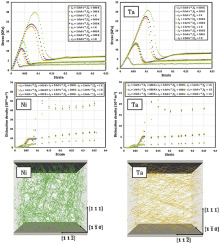当前位置:
X-MOL 学术
›
Acta Mater.
›
论文详情
Our official English website, www.x-mol.net, welcomes your feedback! (Note: you will need to create a separate account there.)
The effects of temperature and strain rate in fcc and bcc metals during extreme deformation rates
Acta Materialia ( IF 9.4 ) Pub Date : 2018-06-01 , DOI: 10.1016/j.actamat.2018.03.029 Mohammadreza Yaghoobi , George Z. Voyiadjis
Acta Materialia ( IF 9.4 ) Pub Date : 2018-06-01 , DOI: 10.1016/j.actamat.2018.03.029 Mohammadreza Yaghoobi , George Z. Voyiadjis

|
Abstract The present work investigates the effects of temperature and strain rate in fcc and bcc metallic samples subjected to the extreme strain rates, higher than 10 8 s − 1 , using large scale atomistic simulation. In addition to the stress-strain curve, the microstructural information of the samples is studied to capture the underlying mechanisms of temperature and rate effects. The results show that as the strain rate increases, the material strength increases in a way that the underlying mechanisms of strength depend on the material crystal structure. However, the results show that the material response dependency on temperature is much smaller than that of the strain rate in the region of extreme deformation rates. In other words, the change in temperature does not lead to a noticeable change in the material response. In the case of fcc metals subjected to the extreme strain rates, the results show that the work hardening mechanism, i.e., interaction of dislocation with one another, is the governing mechanism of material strength, and the contribution of thermal activation mechanism is negligible. In the case of bcc metals subjected during the extreme rate deformations, both work hardening and phonon drag mechanisms are important, while the former one is dominant. Again, the thermal activation mechanisms can be neglected in the regime of high strain rates. Finally, a multi-scale model is incorporated to capture the observed response of material in the regime of extreme strain rates.
中文翻译:

fcc 和 bcc 金属在极端变形速率下温度和应变速率的影响
摘要 目前的工作使用大规模原子模拟研究了温度和应变速率对 fcc 和 bcc 金属样品的影响,这些样品受到极端应变速率,高于 10 8 s - 1 。除了应力-应变曲线外,还研究了样品的微观结构信息,以捕捉温度和速率效应的潜在机制。结果表明,随着应变速率的增加,材料强度以一种强度的潜在机制取决于材料晶体结构的方式增加。然而,结果表明,在极端变形率区域,材料响应对温度的依赖性远小于应变率。换句话说,温度的变化不会导致材料响应的明显变化。在承受极端应变率的面心立方金属的情况下,结果表明加工硬化机制,即位错相互作用,是材料强度的控制机制,热活化机制的贡献可以忽略不计。对于在极端速率变形过程中受到的 bcc 金属,加工硬化和声子阻力机制都很重要,而前者占主导地位。同样,在高应变率的情况下可以忽略热激活机制。最后,结合多尺度模型来捕捉材料在极端应变率范围内的观察响应。是材料强度的支配机制,热活化机制的贡献可以忽略不计。对于在极端速率变形过程中受到的 bcc 金属,加工硬化和声子阻力机制都很重要,而前者占主导地位。同样,在高应变率的情况下可以忽略热激活机制。最后,结合多尺度模型来捕捉材料在极端应变率范围内的观察响应。是材料强度的支配机制,热活化机制的贡献可以忽略不计。对于在极端速率变形过程中受到的 bcc 金属,加工硬化和声子阻力机制都很重要,而前者占主导地位。同样,在高应变率的情况下可以忽略热激活机制。最后,结合多尺度模型来捕捉材料在极端应变率范围内的观察响应。
更新日期:2018-06-01
中文翻译:

fcc 和 bcc 金属在极端变形速率下温度和应变速率的影响
摘要 目前的工作使用大规模原子模拟研究了温度和应变速率对 fcc 和 bcc 金属样品的影响,这些样品受到极端应变速率,高于 10 8 s - 1 。除了应力-应变曲线外,还研究了样品的微观结构信息,以捕捉温度和速率效应的潜在机制。结果表明,随着应变速率的增加,材料强度以一种强度的潜在机制取决于材料晶体结构的方式增加。然而,结果表明,在极端变形率区域,材料响应对温度的依赖性远小于应变率。换句话说,温度的变化不会导致材料响应的明显变化。在承受极端应变率的面心立方金属的情况下,结果表明加工硬化机制,即位错相互作用,是材料强度的控制机制,热活化机制的贡献可以忽略不计。对于在极端速率变形过程中受到的 bcc 金属,加工硬化和声子阻力机制都很重要,而前者占主导地位。同样,在高应变率的情况下可以忽略热激活机制。最后,结合多尺度模型来捕捉材料在极端应变率范围内的观察响应。是材料强度的支配机制,热活化机制的贡献可以忽略不计。对于在极端速率变形过程中受到的 bcc 金属,加工硬化和声子阻力机制都很重要,而前者占主导地位。同样,在高应变率的情况下可以忽略热激活机制。最后,结合多尺度模型来捕捉材料在极端应变率范围内的观察响应。是材料强度的支配机制,热活化机制的贡献可以忽略不计。对于在极端速率变形过程中受到的 bcc 金属,加工硬化和声子阻力机制都很重要,而前者占主导地位。同样,在高应变率的情况下可以忽略热激活机制。最后,结合多尺度模型来捕捉材料在极端应变率范围内的观察响应。



























 京公网安备 11010802027423号
京公网安备 11010802027423号